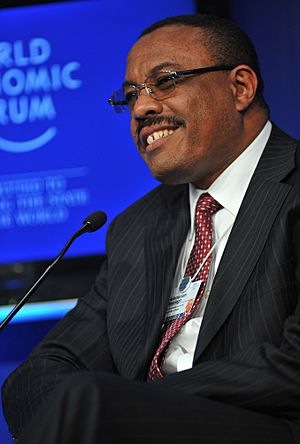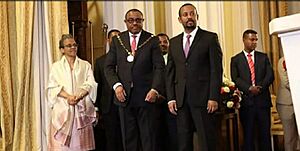Hailemariam Desalegn facts for kids
Quick facts for kids
Hailemariam Desalegn
|
|
|---|---|
|
ኀይለማሪያም ደሳለኝ
|
|
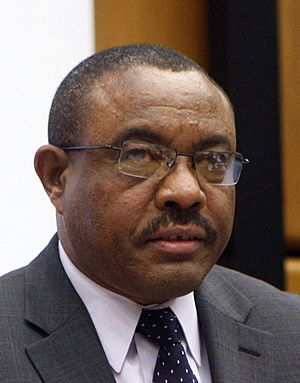
Hailemariam in 2014
|
|
| Prime Minister of Ethiopia | |
| In office 20 August 2012 – 2 April 2018 Acting: 20 August 2012 – 21 September 2012 Caretaker: 11 March 2018 – 2 April 2018 |
|
| President | Girma Wolde-Giorgis Mulatu Teshome |
| Preceded by | Meles Zenawi |
| Succeeded by | Abiy Ahmed |
| 2nd Chairman of the Ethiopian People's Revolutionary Democratic Front | |
| In office 16 September 2012 – 15 February 2018 |
|
| Deputy | Demeke Mekonnen |
| Preceded by | Meles Zenawi |
| Succeeded by | Abiy Ahmed |
| 11th Chairperson of the African Union | |
| In office 27 January 2013 – 30 January 2014 |
|
| Preceded by | Yayi Boni |
| Succeeded by | Mohamed Ould Abdel Aziz |
| Deputy Prime Minister of Ethiopia | |
| In office 1 September 2010 – 21 September 2012 |
|
| Prime Minister | Meles Zenawi |
| Preceded by | Addisu Legese |
| Succeeded by | Demeke Mekonnen Debretsion Gebremichael Muktar Kedir |
| Minister of Foreign Affairs | |
| In office 1 September 2010 – 21 September 2012 |
|
| Prime Minister | Meles Zenawi |
| Preceded by | Seyoum Mesfin |
| Succeeded by | Tedros Adhanom |
| President of the Southern Nations, Nationalities, and People's Region | |
| In office 12 November 2001 – March 2006 |
|
| Preceded by | Abate Kisho |
| Succeeded by | Shiferaw Shigute |
| Personal details | |
| Born | 19 July 1965 Boloso Sore, South Ethiopia Regional State, Ethiopian Empire |
| Political party | Southern Ethiopian People's Democratic Movement |
| Other political affiliations |
Ethiopian People's Revolutionary Democratic Front |
| Spouse | Roman Tesfaye |
| Children | 3 |
| Alma mater | Addis Ababa University Arba Minch University Tampere University of Technology Azusa Pacific University |
Hailemariam Desalegn Boshe (Amharic: ኀይለማሪያም ደሳለኝ ቦሼ) was born on July 19, 1965. He is an Ethiopian politician who served as the Prime Minister of Ethiopia from 2012 to 2018. Before that, he was the Deputy Prime Minister and Minister of Foreign Affairs from 2010 to 2012.
After the death of Prime Minister Meles Zenawi in August 2012, Hailemariam took over as acting Prime Minister. He was then chosen to lead the EPRDF, which was the ruling political party. He also served as the leader of the African Union from 2013 to 2014.
Hailemariam resigned as Prime Minister and party leader on February 15, 2018. He said he wanted to help bring about reforms and peace in the country. His resignation was accepted, and he stayed on as a temporary leader until April 2, 2018. He was the first modern Ethiopian leader to step down from power willingly.
Contents
Early Life and Education
Where Hailemariam Grew Up
Hailemariam was born in 1965 in the Boloso Sore District of the Wolayita Zone in southern Ethiopia. He belongs to the Wolayta ethnic group. His family is part of the Apostolic Church of Ethiopia. He is known as a religious and family-oriented person, married to Roman Tesfaye.
Hailemariam's Schooling
In 1988, Hailemariam earned a degree in civil engineering from Addis Ababa University. He then worked at the Arba Minch Water Technology Institute. He later received a scholarship to study in Finland, where he earned a master's degree in sanitation engineering.
When he returned to Ethiopia, he worked in various roles at the Water Technology Institute, including being its dean, for 13 years. In 2006, he also earned another master's degree in Organizational Leadership from Azusa Pacific University in the United States.
Political Journey
Starting in Politics
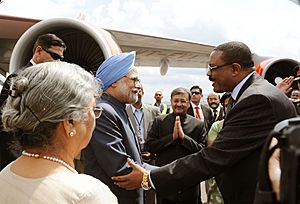
In the late 1990s and early 2000s, Hailemariam became very active in politics. He joined the EPRDF, Ethiopia's main political party. He became the deputy president of the Southern Nations, Nationalities, and People's Region (SNNPR).
He later became the President of the SNNPR from November 2001 to March 2006. In October 2010, he was promoted to Deputy Prime Minister and Minister of Foreign Affairs. He also served as the Deputy Chairman of the EPRDF.
After being President of the SNNPR, Hailemariam advised the Prime Minister on social issues. He helped create a law that limited how much international aid groups could get involved in local politics. He also helped the EPRDF party grow its membership significantly. In 2010, he took on the dual roles of Deputy Prime Minister and Minister of Foreign Affairs.
Becoming Prime Minister
When Ethiopia's long-time Prime Minister Meles Zenawi passed away on August 20, 2012, Hailemariam, as Deputy Prime Minister, became the acting leader. He officially became the Prime Minister on September 21, 2012.
After meeting Hailemariam, the President of the European Parliament, Martin Schulz, said that Hailemariam wanted to make Ethiopia's democracy stronger. He also wanted to allow more freedom for people and groups in the country.
Working with Somalia
In February 2014, Hailemariam met with the Prime Minister of Somalia, Abdiweli Sheikh Ahmed. They talked about making the relationship between their two countries stronger. Hailemariam promised Ethiopia's continued help for peace in Somalia. He also suggested that Ethiopia and Somalia should increase trade and investment.
The meeting ended with agreements to work together on developing Somalia's police force, sharing information, and improving aviation.
Boosting Ethiopia's Economy
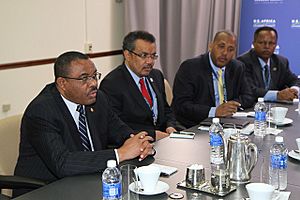
Hailemariam Desalegn continued the economic growth Ethiopia had been experiencing. He helped complete major projects like industrial parks, the Addis Ababa Light Rail, and the Gilgel Gibe III Dam. Under his leadership, Ethiopia continued to see fast economic growth.
He also led Ethiopia to partner with Kenya on a large project called the LAPSSET Corridor. This project includes a railway, highways, and an oil pipeline. It helps Ethiopia, which is a landlocked country, get its goods to ports. Ethiopia also partnered with Djibouti to build a fuel pipeline.
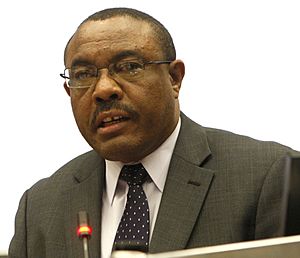
Hailemariam's government also received its first credit ratings from global agencies in 2014. This helped Ethiopia attract more international investments. Much of this investment came from China, which provided loans and grants for big projects like roads and railways.
Why Hailemariam Resigned
On February 14, 2018, Hailemariam Desalegn announced that he was stepping down as Prime Minister and chairman of the EPRDF. He was the first leader in Ethiopia's recent history to resign. He explained that his resignation was "vital" for reforms that would bring lasting peace and democracy. This decision came after a period of public protests and unrest in the country.
He said that "unrest and a political crisis have led to the loss of lives and displacement of many." He stayed on as a temporary Prime Minister until Abiy Ahmed was chosen as the new Prime Minister on April 2, 2018.
After Being Prime Minister
In 2025, Hailemariam was appointed as a mediator by the East African Community and the Southern African Development Community. He helped with peace efforts in the Democratic Republic of the Congo.
Hailemariam and Roman Foundation
In April 2018, Hailemariam Desalegn and his wife, Roman Tesfaye, started the Hailemariam and Roman Foundation (HRF). This is a non-profit organization based in Addis Ababa, Ethiopia.
The Foundation works to improve lives in Ethiopia and across Africa. It partners with governments, communities, and international groups. Its goal is to create "a healthy and economically empowered community in a well-conserved environment."
The HRF focuses on several important areas. These include protecting the environment, promoting ecotourism, improving health for mothers and children, helping women and youth gain financial independence, and supporting sustainable agriculture. The Foundation works through advocacy, joint projects, and building skills.
Other Important Roles
Hailemariam is a board member for several international organizations. These include the International Crisis Group and the Alliance for a Green Revolution in Africa. He also chairs the Hailemariam and Roman Foundation and Tourism Ethiopia.
Leading AGRA

In August 2019, Hailemariam Dessalegn became the Chair of the Board for the Alliance for a Green Revolution in Africa (AGRA). AGRA is an African organization that works to improve food security. It does this by helping small farmers across the continent.
In 2023, he encouraged leaders and partners to support changes in food systems. He said this would help improve people's lives and ensure more food for everyone.
Leading TradeMark Africa
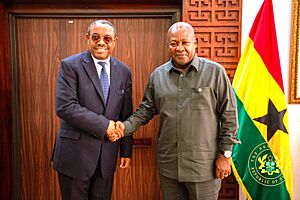
In early 2024, Hailemariam Dessalegn was appointed Board Chair of TradeMark Africa (TMA). TMA is an organization that helps improve trade in Africa. It focuses on making the African Continental Free Trade Area (AfCFTA) work well.
Awards and Recognition
Hailemariam Desalegn has received several honors and awards for his work.
- Romanian Parliament Medal (2015): He received this medal for his excellent work in international diplomacy.
- World Leader of Tourism (2015): He was recognized for helping promote Ethiopia's tourism.
- AfricaWorld Man of the Year (2015): A Pan-African magazine chose him for his leadership and contributions to African development.
- Honorary Professorship (2017): The University of International Business and Economics in Beijing gave him this title for strengthening academic partnerships.
- Ethiopia's Highest National Honor (2018): He received this special medal and award at a farewell ceremony in Addis Ababa. It was given to him by Prime Minister Abiy Ahmed for his leadership and peaceful transfer of power.
- Grand Cordon of the Order of the Rising Sun (2019): The Government of Japan honored him for his contributions to relations between Ethiopia and Japan and for promoting peace in Africa.
- Gifata Award (2019): He received this award from the Welayta people in Wolayita Sodo for his political leadership and academic achievements.
See also
 In Spanish: Hailemariam Desalegne para niños
In Spanish: Hailemariam Desalegne para niños


